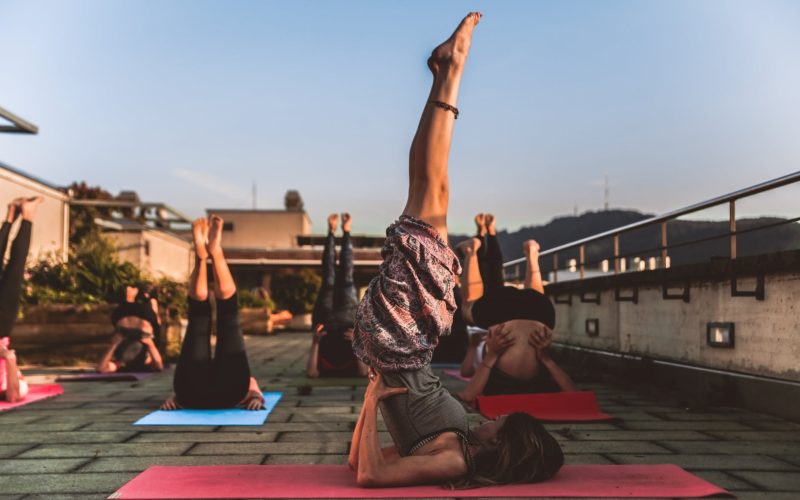4 benefits of yoga at the workspace
Yoga has developed as an extremely popular practice over the past decades. The practice, which most probably originates from ancient India, is now being practiced all over the world and in many different forms. The word yoga originally comes from the Sanskrit word ‘yuj’, which means “to yoke.” Although the meaning has been described in many different ways, the most common way to explain the meaning of the word is the aim to unite the mind, body and spirit.
As often described, the aim of yoga is to bring balance, psychologically, emotionally, spiritually and physically. All these goals are incredibly valuable in our daily lives, which are often full of stress, distractions and unhealthy influences. Especially in the West, many people are living a rushed life and therefore desperately need ways to bring back the balance that is often challenged immensely.
This is most probably why yoga became so incredibly popular in the West; yoga contributes to that balance. Through a regular yoga practice people feel more relaxed, healthier, more confident and better able to deal with challenges in general. On top of that, people who practice yoga regularly tend to be less vulnerable for illness.
Perfect for everyone right? And especially perfect for working individuals and their employer – if they have one. This is why yoga at office spaces has become very popular over the past decades. More and more companies and co-working spaces offer yoga classes to their community, with great results.

We looked into the main effects of yoga at the workspace and made a list of four valuable benefits of yoga on work performance and happiness at work.
Reduction of stress levels.
Stress is one of the main threats to the workforce. Employers, employees and self employed working individuals all deal with it, and the effects of stress can be huge. Stress decreases productivity and therefore simply costs time and money, but also often results in physical problems, whichcan be hard to treat.
Yoga is a great way to reduce stress in many ways: You simply learn to relax your body and become aware of your breathing through breathing exercises- or pranayama practices. When under stress, we often breathe fast, without noticing. Learning to be aware of this and change it when necessary, can bring down our stress levels tremendously. Yoga’s physical side, the asanas or yoga postures, release energy, and – when challenging at times – can teach us to deal with challenges and stress. Knowing how to face challenges on the mat, teaches us a lot about how to face them in the outside world too.
Did you know that yoga even chances your brain? When practicing yoga regularly, both our somatosensory cortex (the mental and sensational map of the body) and the hippocampus (responsible for management of stress and anxiety) grow.
Also, yoga stimulates the parasymphatic nervous system , which has a calming effect and helps us deal with stressful events and recover from shock.

Increase of positivity and happiness.
The last thing you want in your day-to-day life is irritation and sadness. It’s commonly known that happiness brings productivity, creativity and helpfulness. Also, mostly for social jobs, happiness and positivity simply make us more successful at work.
Most people, who have attended a yoga class before, know the almost euphoric feeling we can have after a nice class. You feel energized, fit and relaxed at the same time.
This feeling may have different reasons. Firstly a very simple one; we are proud of ourselves for making it onto our mat. We feel good about the fact that we took time for ourselves and worked on our health. And, simply, we enjoyed the class.
Secondly, healthy people are happier. When we feel strong and flexible, we simply have less to worry about and feel better in our bodies.
Thirdly, the happiness we feel from regular yoga practices may have a neurological reason too. Apart from the stress related effects as described above, researchers have found that yogis have a higher level of GABA in their brain . Increased GABA levels have been found to be related to improved mood and decreased anxiety.
Apart from GABA, yoga and more specifically meditation, have been found to increase serotonin and oxytocin levels. All these chemicals are responsible for a good mood and decreased stress and anxiety levels.
Improvement of posture and physical strength.
Especially for those with office jobs, pain in the body is a common problem. Sitting in the same position all day can result in many injuries, with lower back pain as the most common one – and many arm, neck and hand related injuries following. Although a lot can be done with measuring a perfect working desk and chair, sitting in the same position is just a huge strain on our body.
And let’s be honest, when you are in pain, you are not happy and productive.
Especially the asanas, the physical postures of yoga, improve our posture and physical health significantly. The very common postures that are used in different types of yoga to relief back pain easily are for instance ‘child’s pose’, ‘downward facing dog’, ‘cat-cow movements’ and certain twists.
For arms and shoulders, certain hand – and shoulder stretches and for instance ‘eagle’ pose give immediate relief.
Apart from this, practicing yoga makes us flexible, strong and therefore prevents further injury significantly.
Improvement of concentration and focus.
A last but not least benefit of a regular yoga practice on our performance and happiness at work, is an improved concentration and focus. When working concentrated and focused, we simply get more work done. This saves time and money and simply makes us feel better about ourselves.
Although there are many practices and exercises available for improvement of concenration, yoga may be the oldest one.
How does yoga improve concentration and focus? To start with, by decreasing stress and pain, the most common distractions are already removed from our mind. This simply makes concentrating easier.
Also, pranayama (breating) exercises and meditation teach yogis to focus on something specifically and filter out distractions that are not relevant for them at that moment.
Studies have actually shown that people practicing yoga have a significantly better focus, even compared to people doing other forms of exercise. The reasons for this difference are not fully clear, but it has been suggested that self-awareness through meditation and the reduction of anxiety and stress are the main ones.
At Anda Cowork we believe that offering our co-workers weekly yoga classes can make a huge difference for them in their productivity, happiness and health. We offer a weekly yoga class on Wednesday evenings and still have a few spots open for new students. Are you interested in joining us? You can find more information about Anda at https://www.andacowork.com and book your mat in class via info@granadaspirit.com.

No Comments
Be the first to start a conversation